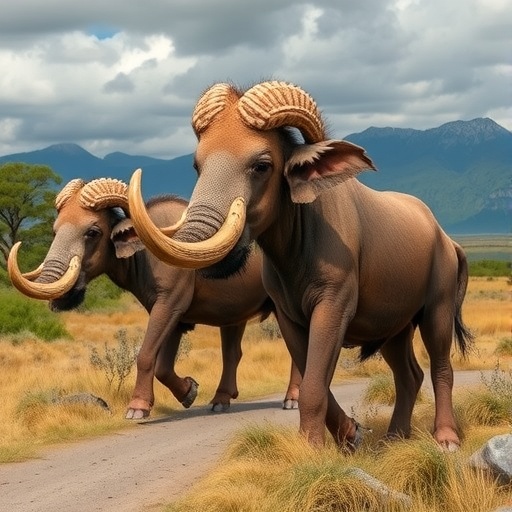A groundbreaking study unveiled today in Science Advances has dramatically reshaped our understanding of mastodon evolution, offering unprecedented insights into the migratory behavior and genetic diversification of these Ice Age giants across North America. Employing cutting-edge ancient DNA reconstruction techniques, an international team of researchers from McMaster University and Harvard has decoded mitochondrial genomes from fossilized mastodon remains, revealing complex patterns of dispersal, speciation, and interbreeding that challenge long-held assumptions about this iconic species.
The team meticulously analyzed well-preserved fossilized teeth, tusks, and bone fragments dating back hundreds of thousands of years. These specimens, which originated from diverse geographic areas including the Pacific Northwest, Nova Scotia, the eastern seaboard, and Northern Ontario, contained highly degraded ancient DNA fragments that posed significant technical hurdles. By harnessing state-of-the-art genetic sequencing technologies and bioinformatic methods, the researchers succeeded in reconstructing complete mitochondrial genomes, providing a high-resolution window into mastodon population dynamics over millennia.
One of the most remarkable revelations was the clear genetic distinction of Pacific mastodons, now designated as Mammut pacificus. This lineage, previously debated among paleontologists, was proven to belong to an ancient and deeply divergent branch, whose range extended much further than was earlier assumed. Contrary to prior beliefs that confined Pacific mastodons to a relatively narrow corridor, their distribution apparently reached as far south as Mexico and stretched northward into Alberta. This expanded geographic scope illustrates the remarkable adaptability and ecological plasticity of these Ice Age elephants in response to fluctuating climates.
Alberta emerged as a critical focal point in the new evolutionary landscape of mastodons. Genetic evidence indicates that this region functioned as a dynamic migratory corridor where Pacific and American mastodon populations converged and potentially interbred. This finding challenges the simplistic notion of isolated species ranges and underscores the complex biogeography shaped by glacial cycles. The possible hybridization events have profound implications for understanding how peripheral populations contributed to speciation and adaptive radiation in Pleistocene megafauna.
In the eastern part of North America, the researchers uncovered an unexpected wealth of genetic diversity within mastodon populations. Analysis revealed at least two distinct mitochondrial clades that occupied overlapping territories but existed in different temporal windows. These groups arrived in multiple waves, at least three distinct migrations, corresponding with interglacial periods when climate warming induced glacial retreat. Such recurrent northward expansions emphasize the strong influence of climate oscillations on mastodon dispersal patterns and habitat availability.
The cyclical nature of Ice Age climate was a crucial factor driving mastodon population dynamics. As global temperatures rose and glaciers melted, mastodons exploited newly accessible northern territories, expanding their ranges. Conversely, cooling phases and glacial advances forced populations southward or triggered localized extinctions. This recurrent push and pull likely fostered repeated episodes of genetic bottleneck and demographic change, leaving complex signatures in the mitochondrial genomes now decoded.
Adding another layer of complexity, the research team identified a mysterious and genetically distinct Mexican mastodon lineage. While its precise taxonomic placement remains unresolved, preliminary genetic data suggest it could represent a basal branch of the Pacific mastodon clade or potentially a previously unrecognized third species. This discovery highlights southern North America as an underexplored frontier for mastodon evolutionary history and calls for further paleogenomic investigations in the region.
From an ecological perspective, mastodons occupied niches markedly different from their more famous relatives, the woolly mammoths. As specialized browsers, mastodons thrived in swampy environments rich in shrubs and low-hanging vegetation, contrasting with mammoths’ preference for grasslands and tundra. This niche partitioning allowed the two proboscidean groups to coexist in overlapping regions without direct competition, informing paleoecological reconstructions of Ice Age landscapes.
The study’s principal investigator, Hendrik Poinar, director of the McMaster Ancient DNA Centre, emphasized how these findings revolutionize our understanding of the North American Ice Age landscape. According to him, regions previously considered marginal habitats for mastodons, particularly northern territories like Alberta, were in fact vibrant centers of ecological activity and genetic exchange. This conceptual shift influences not only paleontological frameworks but also modern conservation biology, offering analogies for how large mammals might respond to ongoing climate change.
Lead author Emil Karpinski, now at Harvard Medical School, underscored the multifaceted nature of mastodon populations, raising new questions about species interactions. Were the Pacific and American mastodons competitors, or did they interbreed freely? Are hybridization events frequent enough to warrant rethinking species boundaries within Mammut? These inquiries open avenues for comprehensive genomic studies incorporating nuclear DNA and advanced modeling of population dynamics.
Complementing earlier research published in 2020 by the same team, the current work paints a far more intricate portrait of mastodon biogeography, evolution, and adaptation. Through genomic reconstructions spanning temporal and spatial dimensions, scientists can now trace the evolutionary narratives of these megafauna with unprecedented clarity. Such insights not only enrich our understanding of past biodiversity but also provide vital analogs for predicting how contemporary species might adapt or perish amid rapid environmental transformations.
In conclusion, this landmark study not only revises mastodon taxonomy and migratory history but also showcases the transformative power of ancient DNA technology in unraveling evolutionary mysteries. As the Ice Age giants continue to captivate scientific imagination, these new genetic narratives bring us closer to comprehending how life on Earth responds, survives, and thrives amid the uncertainties of changing climates.
Subject of Research: Animal tissue samples
Article Title: Repeated climate-driven dispersal and speciation in peripheral populations of Pleistocene mastodons
News Publication Date: 12-Sep-2025
Web References: http://dx.doi.org/10.1126/sciadv.adw2240
Image Credits: McMaster University
Keywords: DNA, Ancient DNA, Mastodon, Pleistocene, Evolution, Migration, Climate Change, Speciation, Genetics, Paleogenomics, North America




